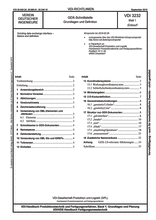
Draft technical rule
VDI 3232 Blatt 1:2015-09 - Draft
Grinding data exchange interface - Basics and definiton
- German title
- GDX-Schnittstelle - Grundlagen und Definition
- Publication date
- 2015-09
- Original language
- German
- Pages
- 35
- Publication date
- 2015-09
- Original language
- German
- Pages
- 35
Product information on this site:
Quick delivery via download or delivery service
Buy securely with a credit card or pay upon receipt of invoice
All transactions are encrypted
Short description
The use of cutting tools is due to very complex geometry-combinations in the tools especially confusing if the tools are sharpened in continuous production process, or need to be replaced. They must go through the entire process from CAD system via the NC-grinding up to the measuring machine for quality assurance and the data exchange between these process steps must function properly and user-friendly, even between different manufacturers of the components, meaning different machine tools from different manufacturers must be able to produce identical cutting tools. The virtual development of cutting tools has not yet become accepted due to the lack of data consistency, because the high complexity of descriptive geometry-shapes (e.g., twisted flutes and rear and free of cuts cutting tools). The tool-grinding machines differ depending on the manufacturer and model structure, kinematics, NC-programming system and the user interface. Equivalent grinding operations and the grinding results of each programming systems differ by a lot of parameter designations and definition options from each other, and the data-sets of different NC-programming systems are incompatible with each other. Therefore the data exchange is not readily possible. Due to these problems an open data interface called GDX (grinding data exchange) has been developed that allows the limited data exchange between the NC programming system of the grinding tool, the CAD system and the tool measuring machine without problems. This standard provides the basis for the uniform definition of the GDX interface as of version GDX-2.0, and applies in conjunction with all other parts of the series of standards VDI 3232. This standard defines the basic structure and rules for the syntax and contents of the GDX exchange format.
Content
ICS
25.040.20,
25.080.01,
35.240.10
Also available in
Loading recommended items...
Loading recommended items...
Loading recommended items...

